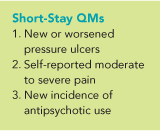Trending Up The Center’s QM Five-Star Rating
Getting a handle on how one’s facility is doing on its quality numbers can help point a provider in the right direction.
Lisa Hohlbein, RN
12/1/2015
Often the first time administrators see their Five-Star ratings is when they are posted on Nursing Home Compare. When the rating is less than desired, facility staff scramble to identify system weaknesses and work to shore up problems, attacking the rating reactively. What if providers could be proactive and anticipate their quality measures ratings before the public sees them? Keep reading to find out how.
Setting The Stage
The Centers for Medicare & Medicaid Services (CMS) developed the Five-Star Quality Rating System in 2008. The primary goal of this program is to provide the public with an easy way to understand assessment of nursing center quality, making meaningful distinctions between high- and low-
performing facilities.
There are three domains included in this facility measurement, each of which has its own five-star rating:
- Health Inspections. Measures based on outcomes from state health inspections;
- Staffing. Measures based on nursing center staffing levels; and
- Quality Measures. Measures based on Minimum Data Set (MDS) data.
CMS’ Five-Star program is closely aligned with the National Quality Forum, with an emphasis on value-based programs and quality-driven care. It is of most importance to have in place programs, services, and technologies designed to enhance quality and produce positive health outcomes for all residents in a facility. Through proactive identification and focus on key measures having the greatest impact, facilities can begin to know where to focus clinical system interventions leading to better quality care.
Predicting or foreshadowing data analytics can help to track performance, identify and prioritize opportunities, and develop quality improvement plans. The Quality Measure domain is one area that is worthy of such a focus.
QM Methodology
A set of
quality measures (QMs) has been developed where the data come directly from the MDS. They represent residents’ functional health status in a number of care areas. Facility QM ratings are based on performance on 11 of the 18 QMs that are currently posted on the Nursing Home Compare website. These include eight long-stay measures and three short-stay measures:
It is vital to proactively project if the residents’ QMs are moving in the right direction to improve a facility’s overall rating. The important up-front work done to develop and maintain strong, effective clinical systems will result in QM scores that validate the high-quality care being provided. Identifying trends early can open up opportunities to work on projected outcomes through the Quality Assurance Performance Improvement (QAPI) process.

Data for the QM domain are derived from the three most recent quarters available. Points are assigned for each QM based on the facility’s performance and divided by quintiles:
- 100 points for the best-performing quintile
- 40, 60, or 80 points for the 2nd through 4th quintile (restraints and short-stay pressure ulcer have different scoring methodologies)
- 20 points for the poorest quintile
The quintiles are based on the national distribution for all of the QMs except for the ADL measure, which is a state-specific distribution. All of the 11 QMs are given equal weight. The points are summed across all QMs to create a total score for each facility. The total possible score ranges between 220 and 1,100 points with the follow star ratings:
The adjusted three-quarter QM values for each of the 11 QMs used in the Five-star Algorithm are computed as follows:
Where QMQ1, QMQ2, and QMQ3 correspond to the adjusted QM values for the three most recent quarters and DQ1, DQ2, and DQ3 are the denominators (number of eligible residents for the particular QM) for the same three quarters. This time period specification was selected to increase the number of assessments available for calculating the QM rating, increasing the stability of estimates and reducing the amount of missing data.
Lisa Hohlbein, RN, RAC-MT, CDP, CADDCT, is a curriculum development specialist for the American Association of Nurse Assessment Coordination. She can be reached at (800) 768-1880.